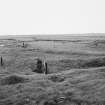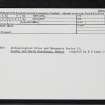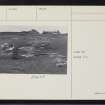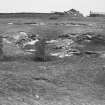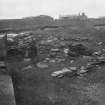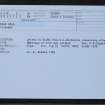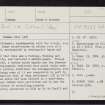Pricing Change
New pricing for orders of material from this site will come into place shortly. Charges for supply of digital images, digitisation on demand, prints and licensing will be altered.
North Ronaldsay, Howmae Brae
Roundhouse(S) (Iron Age), Settlement (Iron Age), Wheelhouse (Iron Age)
Site Name North Ronaldsay, Howmae Brae
Classification Roundhouse(S) (Iron Age), Settlement (Iron Age), Wheelhouse (Iron Age)
Canmore ID 3691
Site Number HY75SE 5
NGR HY 75827 52289
Datum OSGB36 - NGR
Permalink http://canmore.org.uk/site/3691
- Council Orkney Islands
- Parish Cross And Burness
- Former Region Orkney Islands Area
- Former District Orkney
- Former County Orkney
HY75SE 5 7583 5227
(HY 7583 5227) Howmae Brae (NR)
OS 6" map, Orkney, 2nd ed., (1900).
An Iron Age settlement, contemporary with the brochs, consisting of two large round-houses on either side of a paved courtyard, accompanied by rectangular byres and steadings.
Finds indicated that this was a farming, fishing and whaling community, and included a saddle-quern. Though no metal survived, a broken knife handle and the absence of many stone implements indicated that metal tools were available. The pottery confirmed the contemporaneity with the brochs although some of it was comparable in part to that from the earlier Calf of Eday settlement (HY53NE 19).
The round-houses which had been erected in a sand-dune, both had internal radial slab partitions and in one the wall showed evidence of corbelling inwards. The site was partly excavated in 1884 by Dr Wm Traill and in 1889 by John Traill, the finds being donated by NMAS.
The site now has the appearance of a mound 150' E-W and 250' N-S.
W Traill 1885; J Traill 1890; RCAHMS 1946, visited 1928; J R C Hamilton 1968.
All that can be seen of this settlement on Howmae Brae, now overblown with sand, is the SE arc of a wheelhouse (i on Traill's plan), 5 courses high; two upright slabs, being the ends of radial piers; and amorphous traces of walling.
Re-surveyed at 1/2500.
Visited by OS (NKB), 22 July 1970.
Orkney Smr Note (July 1979)
Settlement of wheelhouses excavated W Traill 1884, J Traill
1889. [R1], [R2]
RCAMS summaries excavation reports. [R3]
Hamilton interprets as Iron Age settlement contemporary with
brochs - 2 large roundhouses on either side of a pared courtyard
accompanied by rectangular byres and steadings. [R4]
All now visible is SE arc of a wheelhouse (i on Traill's
plan) 5 courses high; 2 erect slabs being ends of radial piers;
amorphous traces of walling. OS visit Jul 70.
Whole area of Howmae is said to be tunneled by underground
buildings which extend as far as the farm of Kirbist; hollow
sound of ground especially notable in frosty weather. [R5]
As described OS except that only a very short length of
apparently straight wall now showing. The sea is seriously
attacking the dunes to the SW, but no settlement traces are now
visible in the erosion exposure.
Information from Orkney SMR (RGL) Jul 79.
Note (1980)
Howmae Brae, North Ronaldsay HY 7583 5227 HY75SE 5
Wheel-houses excavated in the 1880s are covered by blown sand.
RCAHMS 1980
(Traill, W, 1885; Traill, J, 1890; RCAHMS 1946, ii, pp. 48-50, No. 195; Hamilton 1968, 126-7; OR 218)
Field Visit (1999)
A large overgrown mound stands on the site where, in the 19th C, excavations revealed two probable Iron Age houses. The two large round houses stood to either side of a flagged yard, flanked by smaller outbuildings. Built into a sand dune, the houses were radially partitioned and there was some evidence to suggest that they may have had corbelled roofs. Finds from the site include pottery, stone objects and a saddle quern; these were donated to NMAS. The structures are now covered by blown sand. Ref.: Traill, W (1885) 'Notice of excavations at Stennabreck and Howmae in North Ronaldsay, Orkney', PSAS, 19, 1884-5, 14-33; Traill, J (1890) 'Notes on the further Excavations of Howmae, 1889', PSAS, 24, 1889-90, 444, 451-61; RCAHMS (1946), #195; RCAHMS (1980), #107.
Moore & Wilson 1999.
Coastal Zone Assessment Survey, 1999
Publication Account (2002)
HY75 3 HOWMAE ('Howmae Brae')
HY/758523
A 3.0 m (10 ft.) high mound containing a cluster of roundhouses and huts (including at least one wheelhouse) in North Ronaldsay (Cross and Burness parish) was excavated in 1884 and 1889 by Dr W. Traill, proprietor of the island. For its period the exploration seems to have been careful and systematic, and a large number of finds were recovered, and their locations recorded.
After the excavations the exposed buildings suffered from damage and erosion so that, when the Royal Commission's investigator's visited the site in 1928 there was nothing comprehensible to see, and the original excavation report had to be used. Now there are only a few standing stone slabs among grassy hollows, although the arc of a wheelhouse wall was seen in 1970 [1]. It is a pity that so little reliable information is available from the site; the settlement is only about a thousand yards from Burrian broch and must surely have been contemporary with and linked with it (below).
The site
The settlement consisted of a cluster of dwellings formed of pits dug out of the sand and with revetted walls. All the chambers appeared to have been built as a unit with communicating entrances and passages, rather like the much older Skara Brae. There was an apparently open courtyard area among these buildings which was never completely cleared and a paved floor with a drain below led away from it to the NE.
Room i was the oval chamber (7.32 x 4.58 m, or 24 x 15 ft) with radial stone slabs inside so that it resembled a wheelhouse; its internal wallface (which still stood to 6.5 ft.) sloped inwards at a rate of 18 in. in 6 ft. as if the roof had been a beehive dome, which seems rather improbable. It was noted that the radial slabs were all worn, as if cattle had been rubbing against them; two had holes bored through them about 45 cm (18 in.) above the floor. No hearth was recorded in this chamber but in k there was an arrangement of slabs on end to form the backs of three fireplaces.
Many more details were observed and described [4]. Dr Traill also recorded the details of which finds were found on what part of the site [2,3].
Discussion
In the absence of modern stratigraphical data and of C-14 dates it is difficult to pin down the age of the Howmae settlement satisfactorily beyond saying that is of Iron Age date. Not much more than twenty years ago the presence of the long-handled bone combs would have been taken as a sure sign that the settlement belonged to the middle phase of the Iron Age, spanning a period several hundred years long starting in the 1st century BC (or possibly the 2nd). Now however a form of long comb -- not quite typical of the broch/wheelhouse examples -- has been found in what may be early Iron Age context in Orkney, inside the underground chamber which was built after the Bu roundhouse had been abandoned. Unfortunately, although the roundhouse itself is well dated to the early Iron Age, it is not clear how much later the souterrain was.
Another object which might indicate a really early date -- if correctly diagnosed -- is the bone handle. This piece of rib has been cut to resemble a copy of the hilt of a late Bronze Age bronze knife and could be pointing at an age of the 7th / 6th centuries BC for the settlement. Another rib knife resembles to some extent one found in the Phase 1a levels (late Bronze Age or early Iron Age) levels at Dun Mor Vaul on Tiree (MacKie 1974, fig. 11, no. 45). Likewise the surviving pottery is remarkably similar to the early Dunagoil ware from the same early levels at Dun Mor Vaul and only simple, plain, gritty, barrel-shaped urns seem to be present. There seem to be no sherds of the smoother Orkney broch pottery. In addition no rotary querns were reported from the site which did however yield one saddle quern; this might be very strong evidence in favour of an early date.
Against this early Iron Age date and in favour of contemporaneity with first occupation of the nearby broch are perhaps the long-handled combs from Howmae which are quite similar to those from Burrian (Illus. 5.134). In particular may be noted GO 4 which has incised decoration on it like part of a St. Andrew's cross; the full cross is on GB 87 from Burrian. It might also be argued that the existence of one near-circular stone hut at Howmae with radial partitions of stone slabs means that the settlement was contemporary with the brochs; several Orkney brochs have revealed similar arrangements inside, including Burrian. However the early Iron Age round-house at Bu had some radial slabs and at least one of the stone huts of the contemporary village at Jarlshof, Shetland, had radial stone piers.
Concerning querns, although no rotaries were reported by Dr Traill to have been found at Howmae, it is curious that there are several ancient-looking querns at a house not far from Howmae, at Kirbist. However these stones could of course have come from Burrian broch.
In conclusion one has to admit that the evidence for the dating of Howmae is somewhat contradictory. While the settlement could be several centuries older than the brochs the author is at present inclined, provisionally, to set it in the middle Iron Age and to suppose that its inhabitants retained a more primitive material culture, with some old local roots, than the inhabitants of Burrian broch not far away. This particularly applies to the Howmae pottery which is of a kind which we now know probably to have been ubiquitous in the late Bronze Age in the Western Isles (as shown at the site of Cladh Hallam in South Uist: MacKie 2001, 361). However the fact that none of the few well dated early Iron Age sites in Atlantic Scotland has produced classic long-handled combs, whereas those from Burrian match those from Howmae quite well, seems reasonably conclusive.
Finds
The following list (minus amorphous pieces) is taken from Dr Traill's second article [3, 457]. Bone implements: 4 long-handled combs (GO 1-4), a fragment of a whale vertebra cup, probable perforated stool seat made from a whale vertebra, 1 incomplete needle (GO 203), 49 pins and bodkins, mostly polished by use (GO 22), 20 sharp bodkins made from the leg bones of animals (GO 37 and 170), whalebone spindle whorl (GO 55), and a curved, flat, spatulate tool with a perforation at the narrow end (GO 187). Among the long list of other objects, not easily recognisable from verbal descriptions, are a rib cut into what looks like the haft of a late Bronze Age bronze knife, a small, rounded hook (number not noted), a long rib knife (GO 188), a possible haft of a knife of white, polished bone (GO 185), a straight sliver of bone with a fine zig-zag pattern incised along it (GO 230) and a curious elongated object with rounded ends and concave side, with two large perforations -- perhaps a toggle of some kind (GO 184). In addition there are large quantities of large pieces of worked bone.
Stone implements included 16 hammer stones, a disc of slaty stone, 2 massive and thick discs (5-6 in. in diameter and 1-2 in. thick), a sandstone saddle quern, 7 pieces of worked pumice and a number of other worked stone implements. There were also at least 3 struck stone flakes.
Pottery: Traill reports "several fragments of rims and side of vessels of coarse, reddish ware" and these include a simple rim sherd of a barrel-shaped urn of hard, gritty Dunagoil ware (GO 96, 97) and slightly footed base sherds of the same pottery. The wall sherds are ring-built and are mainly dark grey or black in one half and brick red in the other.
Sources: 1. OS card HY 75 00: 2. Traill 1985, 23-32: 3. Traill 1890: 4. RCAHMS 1946, 2, 48, no. 195.
E W MacKie 2002















